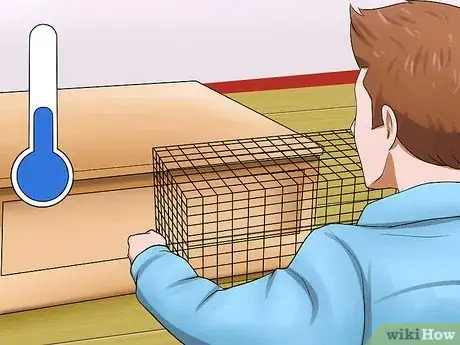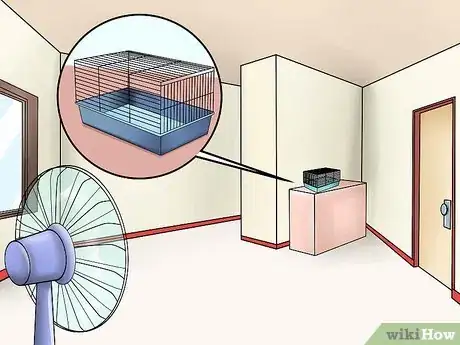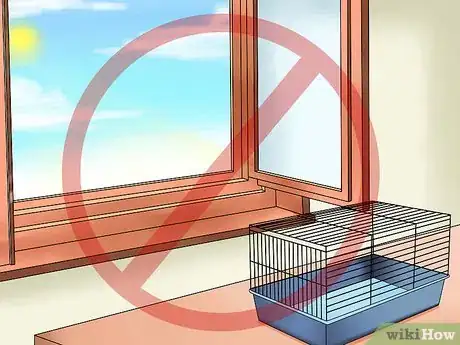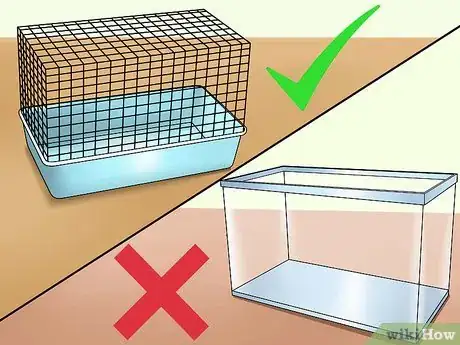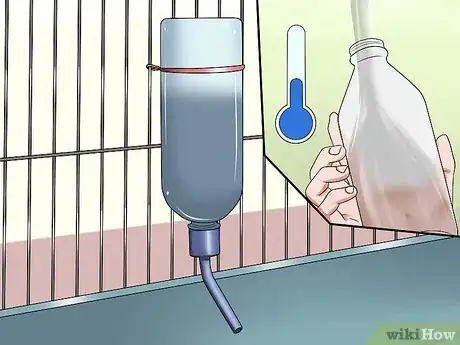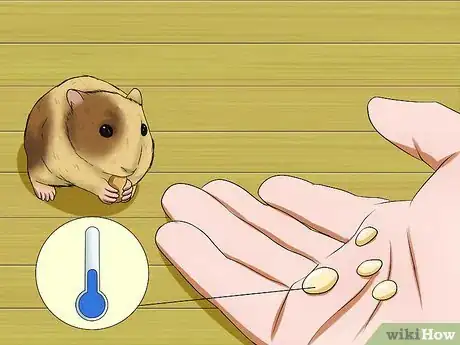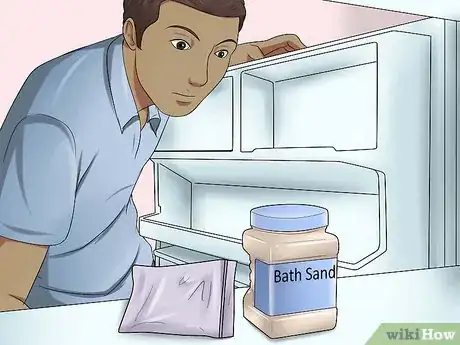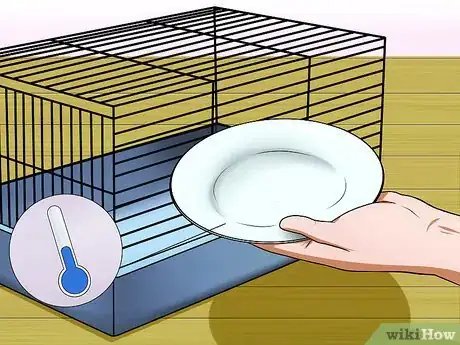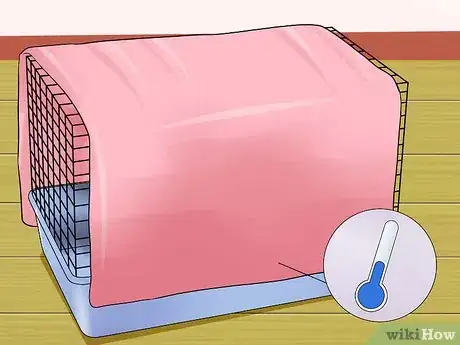This article was co-authored by Pippa Elliott, MRCVS. Dr. Elliott, BVMS, MRCVS is a veterinarian with over 30 years of experience in veterinary surgery and companion animal practice. She graduated from the University of Glasgow in 1987 with a degree in veterinary medicine and surgery. She has worked at the same animal clinic in her hometown for over 20 years.
There are 8 references cited in this article, which can be found at the bottom of the page.
wikiHow marks an article as reader-approved once it receives enough positive feedback. In this case, 96% of readers who voted found the article helpful, earning it our reader-approved status.
This article has been viewed 201,042 times.
Hamsters are most comfortable in 65-75°F (18.33-23.89°C) temperatures.[1] If it is any warmer than that, you should make sure your hamster stays cool. Hamsters cannot sweat like humans, so it is up to you to make your pet happy and comfortable during hot weather.
Steps
Avoiding Overheating
-
1Watch for overheating. Hamsters are very sensitive to the heat and can overheat easily.[2] Keep an eye out for these symptoms of heatstroke:
- Panting
- Bright red tongue
- Slobbering
- Depression
- Weakness
- Lack of movement
- Convulsions
-
2Move his cage to cooler part of the house. Walk through your home and try and find where it is the coolest. Try and move your hamster’s cage there.
- Place the cage in a lower part of the house. Heat rises, so the coolest part of your house might be in a basement.
- Another cool place is a bathroom or kitchen. Tile can be cool and provide a comfortable place for your hamster.
Advertisement -
3Use a fan. You do not want to use a fan directly on your hamster as it can add stress to your hamster or make it too cool. Instead, make sure the room where the cage is located is well ventilated and has a good fan. This will help circulate the air and keep the room cool.[3]
-
4Avoid direct sunlight. Do not put your hamster’s cage in direct sunlight. On hot days, make sure the cage is out of reach of the sunlight filtering through the windows. This can easily cause heatstroke in a hamster and other small animals.
- Avoid other heat sources like fireplaces, stoves, and heaters.
-
5Well ventilate the cage. Make sure your hamster has ventilation in his cage. Experts prefer wire cages for this reason, as opposed to aquariums.[4]
- If your hamster is kept in an aquarium, it is especially important for it to be placed in a well ventilated room![5]
-
6Use cool water. An easy way to keep your hamster cool is to provide cool water. Hamsters can become dehydrated quickly, and it is important to always supply a source of fresh, clean water.
-
7Limit playing. Hamsters do not have the ability to sweat, so they are in danger of becoming dehydrated more quickly than mammals. It is important to limit playing with your hamster in hot weather to avoid overheating.[6]
- If you want to handle your hamster, try in the early mornings or at night when the temperature is cooler.
-
8Never leave your hamster in a hot car. Never leave a hamster, or any animal, in a vehicle during warm weather! The inside of a car can reach deadly temperatures. If you are taking your hamster to the vet or traveling with him, take care to keep your hamster safe from dangerous temperatures.[7]
Utilizing the Freezer
-
1Give frozen treats. A frozen variety of your hamster’s favorite treat is a great way to cool him down on a hot day. Be careful to stick to treats that are safe for your hamster. Consider freezing:
- Barley
- Cashews
- Flaxseeds
- Millet
- Oats
- Peanuts
- Pumpkin seeds
- Sesame seeds
- Cooked potato
-
2Provide a frozen water bottle. Fill a water bottle (or an empty soda bottle) about halfway with water. Wait until it freezes solid. Then, wrap it in a towel or cloth and place it in your hamster’s cage.
- Make sure you wrap the bottle. The frozen bottle can hurt your hamster’s skin.
- A good tip is to freeze the bottle on its side. That way, when you place it in the cage, the hamster has more to lay against.
- You can also use a frozen ice pack.
-
3Freeze bath sand. Hamsters like to bathe in bath sand. You can treat your hamster to a cool bath by freezing his bath sand.[8] Try taking a cup of sand and placing it in a zip-lock bag. Put the bag in the freezer for a few hours, remove the sand from the bag, and place it in the hamster's cage.
-
4Freeze his ceramic housing. If you have a ceramic house in your hamster’s cage, you can freeze it for a few hours to create a cold habitat. Ceramic holds temperature well and can provide a cool haven for an overheated hamster.[9]
- Alternatively, you can use a frozen ceramic tile or marble square in his cage.
-
5Drape a frozen towel over or around the cage. Dampen a towel and freeze it for a few hours. Drape it around the outside of the hamster’s cage, wrapping it around the bottom of the cage. This will create a cold barrier that your hamster can lay against.
- Make sure you do not block the airflow from your hamster’s cage with the towel.
Warnings
- Making your hamster too cold can be just as dangerous as overheating him! Keep a close eye on how hamster to make sure it is acting appropriately.⧼thumbs_response⧽
Things You Will Need
- Access to a freezer
- A fan
- Towels
- Treats
- Ceramic/metal housing or plate
- Water
- Water bottle
References
- ↑ http://www.humanesociety.org/animals/hamsters/tips/hamster_housing.html
- ↑ http://www.peteducation.com/article.cfm?c=18+1800&aid=3411
- ↑ http://www.smallanimalchannel.com/critter-experts/hamster/hamster-comfort-during-seasonal-changes-1310.aspx
- ↑ http://www.humanesociety.org/animals/hamsters/tips/hamster_housing.html
- ↑ http://www.humanesociety.org/animals/hamsters/tips/hamster_housing.html?credit=web_id83488339#Aquariums
- ↑ http://www.sciencedirect.com/science/article/pii/0300962974901248
- ↑ http://www.humanesociety.org/animals/resources/tips/pets_safe_heat_wave.html
- ↑ http://www.smallanimalchannel.com/critter-experts/vet/hamsters-and-scented-sand-1505.aspx
- ↑ http://aaccm.org/wp-content/uploads/2014/05/The-Hot-and-Cold-Facts-of-Ceramics_2012_Du_Co.pdf
About This Article
The ideal temperature for a hamster is 65-75°F, so if it’s warmer than this you should take steps to make sure that your hamster stays cool. Firstly, move the hamster’s cage to a cooler part of your home and ensure that the cage isn’t in direct sunlight. Basements, bathrooms, and kitchens all tend to be cooler areas in a house. Next, make sure that the hamster always has access to fresh water. Fill up the water container with cool water each day and replace the water if it gets too warm. Finally, make sure that you look out for signs of overheating in your hamster. If your hamster starts panting, has convulsions, or has a bright red tongue, help it to cool down immediately and seek veterinarian treatment. For more information on how to keep a hamster cool in hot weather from our Veterinarian co-author, like how to make frozen treats, read on!

